What is this variety of Weeping Alaskan Cedar Called
I need help in identifying a certain variety of Weeping Alaskan Cedar. There are 6 pictures attached. The are all apparently called Weeping Alaskan Cedars or Chamaecyparis (renamed Cupressaceae apparently) Nootkatensis. The top 3 and bottom 2 on the left are all the same variety of this tree (the top leftmost pic is a close-up view of the one to the right of it), whereas the the picture on bottom row on the far right seems to be another variety.
You'll notice that the first five pictures are Weeping Alaskan Cedars of different ages (the first two being of the same tree). 3 of the 4 are actually in my neighbourhood but the owners do not know where they came from. They are fuller, wider and having cascading branches rather than the less dense, narrower and more pendulus branches in the last picture. Yet all have the same general name. When I google for Weeping Alaskan Cedar some look like the first five pictures, some like the last one, but they are all referred to as with or without the 'Pendula' suffix. When I've gone to nurseries and ask for a Weeping Alaskan Cedar or Cedar 'Pendula' they all look like the last one but that's not the variety I want.
Through online research I have found varieties of this tree as follows (the following words appear after the 'Weeping Alaskan Cedar' or 'Chamaecyparis/Cupressaceae Nootkatensis' name).
Pendula
Variegata
Strict Weeping
Blue Weeping, also referred to as Glauca Pendula or Glauca
Aurea
Jubilee
Green Arrow
Yellow
Does anyone know which variety the one I want is? Or, is Weeping Alaskan Cedar with or without the suffix Pendula simply used interchangeably for what seems to be 2 different varieties?
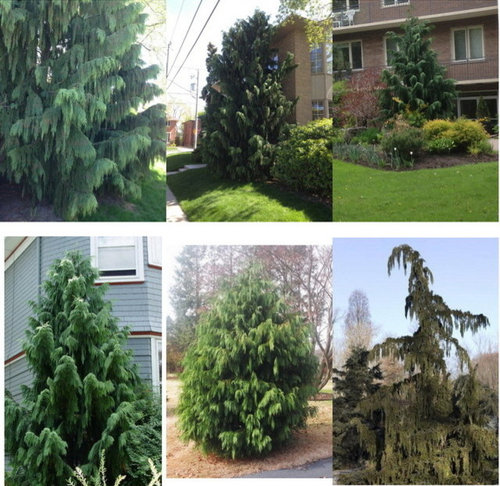
Comments (66)
hipdhop
9 years agolast modified: 9 years agoI believe I have a Chamarecyparis nootkatensis pendula densiform. I'd love an expert confirmation of that though. It's 20' tall, 10' wide and 15yrs old. We are looking to replace it with a smaller one as it will eventually outgrow the space. Which is exactly my question... How much taller/wider will this guy get? (Pic 1 is now... Pic 2 was 15 yrs ago)
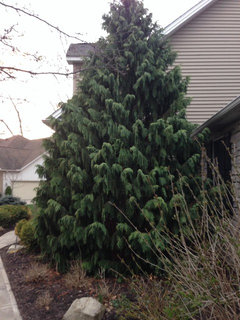
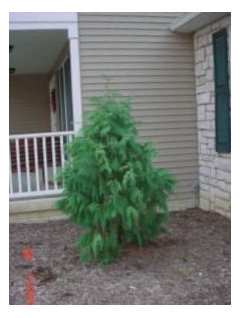
Related Professionals
Maple Valley Landscape Architects & Landscape Designers · Maple Heights Landscape Architects & Landscape Designers · Peabody Landscape Contractors · Athens Landscape Contractors · Belmont Landscape Contractors · Belvedere Park Landscape Contractors · Emmaus Landscape Contractors · Lemont Landscape Contractors · New Baltimore Landscape Contractors · North Haven Landscape Contractors · Tustin Landscape Contractors · Wallingford Landscape Contractors · Wallingford Landscape Contractors · West Haverstraw Landscape Contractors · East Norriton Landscape Contractorsgardener365
9 years agolast modified: 9 years agoNew comments Dave. Someone re-opened it for discussion.
hipdhop: The very best cultivar for that spot is 'Van den Akker'.
Dax
hipdhop
9 years agoThanks Dax. Am I right that the current one (pictured densiform) will grow over 30ft?
eonibm
9 years agoYes, there is one in my 'hood that is that tall.
It doesn't matter what I google. Even 'Chamarecyparis nootkatensis pendula densiform' comes up with trees that are all different. I think one has to just go see the tree at the nursery and make sure it is the one in the picture. However, I have to say the 'densiform' part of the botanical name, if it refers to 'dense' sure describes the tree I want.
No I still haven't got one yet!
gardener365
9 years agoThere is no "densiform" associated with Alaskan cypress. That's why you're not getting anything from your web searches. The easiest way to search is to use "nootkatensis" and then other words such as: Glauca, Van den Akker, Pendula, Sparkling Arrow, Boyko's Sundown, Boyko's Glitter Falls, and so on...
Daxeonibm
9 years agoI wish you were correct but it does not appear that you are.
Actually I AM getting something from my web searches. I didn't say I wasn't. I'll rephrase what I wrote above: 'I am getting tree that are all different but similar including the one I want'. Also, I have searched all of the terms you have mentioned before and they all turn up the same variety of different but similar trees including the one I want. This has been a 3-year quest to find what that tree is called. My conclusion is that there is really no way to determine it's actual botanical name as it's variously called so many different names and those different names also label trees that are different but similar.
The only way to get this tree is to forget what it is called and just find it at a nursery by what it looks like or grow a tree from a branch of an existing one.
gardener365
9 years agoI would have written it earlier but I still agree that it looks like 'Glauca' - even though some are more green than others & the ones that are blue are still more visibly green. There's no question in my mind about it.
Daxeonibm
9 years agolast modified: 9 years agoThe colours may be due to the photographs themselves and not be the actual colour. However, having said that, I am more interested in the look of the tree than the hue of the colour.
Gene Bray
8 years agoI have a 30 year-old tree that is 30 feet high and has vertical weeping branches 3 feet to 5 feet long. It's a classic. The branches are covered in berries and if juniper and cypress berries reproduce faithfully we're in business. If there is any interest I will post pictures. Live in Idaho 83642
Gene Bray
8 years ago
I guess I have created WeepCypress4 ideabook, so I can provide more information. This tree was a transplant 20 years ago as ten year specimen about 12 feet high. It was planted among many conifers, junipers, and an English walnut. These trees furnished an effective windbreak. We irrigate April thru September and it is favorable position. At present at waist-high it is 28 inches - 9 inch diameter. In the pictures the white pole is 20 feet high and one pic shows about 32 feet in height. The drooping limbs are up to five feet in length. See http://homeguides.sfgate.com/reproduce-juniper-plant-32598.html to guarantee a clone. I don't believe they reproduce faithfully from the berries. I welcome any questions an will assist in reproduction efforts.Cat
8 years agoI have one and they are called Blue Atlas weeping cypress. I don't know the botanical name yet, but the pics on images if you google it are exactly what I have. They grow determined by how you let them. They'll keel over if you don't prop them up, but they're so beautiful. Who can resist?
Mike McGarvey
8 years agoStarchild, gotta picture? You probably have a Cedrus atlantica 'Pendula' or 'Glauca Pendula'. I've never seen it confused that way before.
Here's what the species Cupressus nootkatensis looks like. I collected this from the Cascade Mountains myself so I know it's origin for certain.
It is usually listed under Chamaecyparis nootkatensis. The nootkatensis comes from Nootka Sound in the province of British Columbia, Canada.
Mike
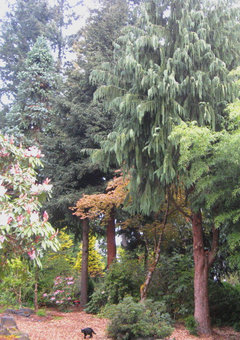
eonibm
8 years agolast modified: 8 years agoYes I think Starchild is referring to one that is like the bottom right tree in my very first post which is not remotely like the other 5 pictures which are all the same type of tree. This thread has not been commmented on in quite a well and it just so happens that after a long time of not seeing any new locations of these trees in Toronto I saw and another young one on Heddington (Eg/Ave Rd) in Toronto a month ago (left pic) and a very mature one of these trees on Kipling St in Toronto yesterday (right pic). Btw, these trees never have to be propped up but grow very tall and straight. The only weeping aspect of these trees are is the weeping growth on each branch. I can't think of an evergreen that I like the looks of more.
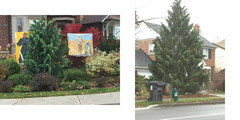
gardengal48 (PNW Z8/9)
8 years agoThe last tree in the original post (far lower right) is also a weeping Alaska cedar/cypress just like the others shown, not a weeping Atlas cedar. It has none of the characteristics of that plant (short needles in clusters, not fans of flattened foliage; a distinctly blue-gray coloration and a very strong tendency to be non self-supporting.....they are highly unlikely to achieve that height without staking).
It is just one of the many narrow cultivars of Chamaecyparis nootkatensis on the market.....perhaps 'Jubilee'. These, along with 'Green Arrow', 'Strict Weeping' and 'Van den Akker', are sold in volume by local area nurseries and are typically seen in clusters or groupings in local landscapes.
The form of Alaskan cedars can be extremely variable, especially when seed grown, as the larger, full ones often are. But they are all just variations of the exact same tree species.
eonibm
8 years agolast modified: 8 years agoThanks. The one I am looking for is the one that looks like the two I just posted two posts back, the one 3 posts back and all but the bottom right one in my first post.
The difficulty appears to be identifying the exact cultivar of Chamaecyparis nootkatensis or Alaskan Weeping Cedar these are. If you google 'Jubilee' and look at the pictures many of the pictures do not look anywhere near the ones I have posted. I guess nurseries don't get too granular with the names. I am finally at the point where I have to replace one of my trees and it is in the perfect place for one of these. Now I have to go and find it. One thing I know for sure is that I will not find it by merely phoning around and asking given how many trees that look entirely different have the same name. Even sending a pic might not do it but that will help to narrow down where to go. I am in Toronto, btw, so if anyone has seen one a nursery in the area or anyway down to Niagara Falls I am game!
Gene Bray
8 years agoI guess I have failed in creating a WeepCypress4 ideabook, so I can provide more information. This tree was a transplant 20 years ago as ten year specimen about 12 feet high. It was planted among many conifers, junipers, and an English walnut. These trees furnished an effective windbreak. We irrigate April thru September and it is favorable position. At present at waist-high it is 28 inches - 9 inch diameter. In the pictures the white pole is 20 feet high and one pic shows about 32 feet in height. The drooping limbs are up to five feet in length. See http://homeguides.sfgate.com/reproduce-juniper-plant-32598.html to guarantee a clone. I don't believe they reproduce faithfully from the berries. I welcome any questions an will assist in reproduction efforts.
eonibm
8 years ago@Gene Bray - I really didn't understand your comment. Could you just add some pics by clicking photo to your reply?
Embothrium
8 years agolast modified: 8 years agoAs naming of these in commerce does not seem to be consistent* your best bet is to shop around and see who - if anyone - appears at this time to be offering the particular forms you are looking for, based on what their stock looks like - rather than getting side tracked by what names are in use, what their correct application may be. With generally similar conifer cultivars the literature is often not adequate to determine how to tell them apart, what the true item looks (or looked) like - the closest thing to an original botanical description is often a brief commercial depiction in a dusty old nursery catalog that appears to be the first mention of the variety. A depiction that may consist entirely of something like "a nice weeper we found in our fields".
*Not all material that looks distinctive has in fact been marketed with its own separate name coined for the occasion - growers often seem to want to cash in on existing, much used names even though their material is derived from their own independent selection, that may sometimes even be more or less unique. It is also true that there is much re-naming of existing introductions, so that some older cultivars in particular have acquired long lists of synonyms. A found plant may have its own name or it may have been listed and sold as another, seemingly different kind - or when it is not an obvious garden hybrid it may have been traded merely as the wild parental species, even though it looks more or less aberrant
mel_van
7 years agoI know it's been almost a year since the last post but for what it's worth I recently bought a 'select' in London Ontario. The image is of the fuller type you're looking for. I Googled every variation of 'select' to little avail... but the four footer I bought does look much different than your sixth photo. Hope this helps!
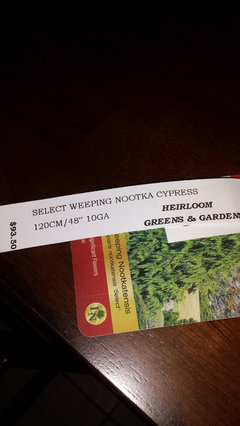 Nootka · More Info
Nootka · More Infoeonibm
7 years agolast modified: 7 years agoThanks so much! That helps a lot. This appears to be one of the most elusive evergreens to find ever. I have now counted only about a dozen in Toronto all around the city and I do drive and cycle around quite a bit. I've been to countless nurseries in the Niagara region and not one has one and not one of them has even seen one before. Would you be so kind as to post a photograph of both the front and back of the coloured tag that only shows partially in the picture you posted? It looks like you bought it at Heirloom Greens & Gardens so I will call them to see if they have them still in stock and perhaps a larger one. I note that the tag also says LN (London Nurseries? or something like that?) with the maple leaf so that is perhaps the grower but I haven't been able to find them online.
Embothrium
7 years agolast modified: 7 years agoPhoto is probably from a stock service and may not show habit of type being offered. Your best bet is to look for plants at outlets or on retailer web sites that appear to have the characteristics you want and get them that way, rather than assuming there is a particular cultivar name in use that is being consistently applied to plants with this level of bushiness, trying to identify and rely on such a name.
eonibm
7 years agolast modified: 7 years agoIt may not show but what if it does? Only one way to know for sure, right? I need to cover ALL bases.
If you read my posts you will see that I've tried the method you have suggested of looking at outlets and retailer websites. It hasn't worked. Also, if you read my first few posts you will see that I am also very aware that I need not assume that a particular cultivar name is consistently applied. It's quite the opposite, especially with this particular cultivar!
Thanks for your input though.
mel_van
7 years agoNo problem. Attaching 2 photos of the actual tree (I know. .. for shame I haven't planted him yet) and the front and back of the tag. Even though he's only 4 feet he indeed doesn't resemble the traditional nootkas I've seen. I bought it Saturday and there was another one at Heirloom. He had a few more dead branches than mine and only a few inches taller. But 40 per cent off. Not sure if it will still be there.... anyways its funny I actually initially wanted one of the typical sixth photo type until I saw this one. But ive been wracking my brains trying to find info on his actual full height and width as some say the tags don't accurately reflect these and as it didn't look like the 'Pendula' I want to know. Good luck and good call on researching the "LN" lead. Looks like Niagara region. I'll do the same! Also I thought I saw another in my neighborhood which is possible given the locale so I'll try to snap a pic... but could be wrong.
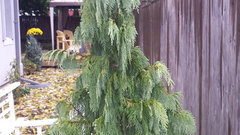
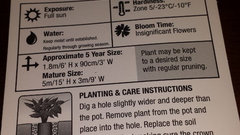
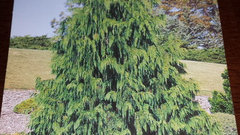
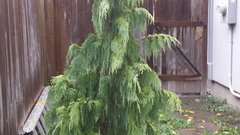
eonibm
7 years agolast modified: 7 years agoThanks. The top and bottom pics of the trees you bought definitely look like what I am looking for. The middle one not quite as much. The back of the tag solved the mystery of where those trees came from. It's not London Nurseries. I entered the postal code from the tag and 'nursery' into the search bar in google maps and up came all of the nurseries in that area. The only one with the initials L & N was Langendoen Nursery and when I went to the website at www.langendoennurseries.com there was the same logo as on your tag. They are a wholesale grower not selling to the public but I am going to call them tomorrow and see who they've shipped these trees to in the Greater Toronto area and whether they have any taller ones available. I'm also curious where they get them from and whether they grow them from seeds or branches.
I emailed the nursery you bought them from but did not hear back.
Thanks so much for helping me to find where I can get one of these.
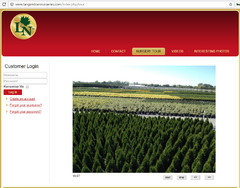
mel_van
7 years agoNice sleuthing! Yeah the pic on the tag is a tad intimidating to me based on size potential... good luck and let me know if you find out anything else!
eonibm
7 years agolast modified: 7 years agoThey appear to be slow growing, perhaps 6-8"/yr or so and, as the tag says, you can prune them. They do fill out width-wise. The biggest one I have seen in Toronto is in Rosedale and looks about 20' high. Here's a more mature one from a MA/CT based grower:

Marie Tulin
7 years agomel van, yours reminds me of the one I bought about 10 years ago. It was upright. Over a period it took a horizontal turn for several feet, and appears to be heading vertically (up) again. It is beautiful but seems to answer to a higher genetic authority.
Do people stake these to keep them growing upright?
Marie
Gene Bray
7 years agoI guess I have created WeepCypress4 ideabook, so I can provide more information. This tree was a transplant 20 years ago as ten year specimen about 12 feet high. It was planted among many conifers, junipers, and an English walnut. These trees furnished an effective windbreak. We irrigate April thru September and it is favorable position. At present at waist-high it is 28 inches - 9 inch diameter. In the pictures the white pole is 20 feet high and one pic shows about 32 feet in height. The drooping limbs are up to five feet in length. See http://homeguides.sfgate.com/reproduce-juniper-plant-32598.html to guarantee a clone. I don't believe they reproduce faithfully from the berries. I welcome any questions an will assist in reproduction efforts.
Embothrium
7 years agolast modified: 7 years agoWhat I was talking about was that your assuming the habit type you were looking was in fact linked consistently, reliably and specifically to a particular grafted named selection may have been a misapprehension. Seed raised, wild origin plants of similar appearance are present in cultivation, in addition to there being indications of comparatively dense and small branched forms being circulated as 'Pendula'. This previously discussed looseness in nursery application of cultivar names for this tree is why you needed to kick tires before buying.
eonibm
7 years agolast modified: 7 years agoSo I called Langendoen Nurseries and they gave me the names of the nurseries they had shipped these trees to in the GTA this year. However, all had sold out. Langendoen grows this cultivar to a maximum of 4' high, which takes about 7 years, and then sells them to nurseries that sell to the public. They told me these trees are propagated by cloning onto root stock.
I did some research (not knowing anything about cloning) and basically by grafting a twig of the plant you want to clone onto a seedling the exact genetic makeup of the tree the twig came from is preserved and the seedling with the twig grafted onto it will grow to look exactly the same. For a conifer you would graft it onto a compatible conifer seedling. Unless otherwise noted by the supplier on the plant tag, cedars are apparently in the public domain so you can graft them. That's why you see on some plant tags 'Propagation prohibited' which is because the grower has a patent on that particular cultivar. At least that's the way I think it works.
Apparently there is more profit in selling smaller trees as you earn your investment back sooner, not to mention transplanting older trees can have more issues. Also, conifers do not grow as fast in eastern Canada as they do in western Canada which is another reason why taller trees are not as plentiful. On top of that trees grown in this area and replanted here in our cooler weather are apparently much hardier than ones grown out west and replanted here because the winters are milder out west. Alton Greenhouses (519-941-4896) in Alton NW of the GTA told me that they can order larger specimens of this tree, say 6-8', for next spring but will not be in ordering mode for another couple of months. Other sources that sold out of them were Glen Echo in Caledon and Terra in Milton. They told me there is also a blue version of this 'Select' cultivar but it is not as hardy.
I think this solves the mystery behind the source of this tree for me! Thanks for everyone's help. Hopefully I will finally have one planted in my garden next spring.
Marie Tulin
7 years agoIt has been interesting to follow this topic. Thanks to all contributors.
Marie
Mike McGarvey
7 years agoI have rooted cuttings from this tree. That is a clone and you don't need to graft. Cheaper, too.
eonibm
7 years agolast modified: 7 years agoNo, you do not need to graft in order to reproduce a particular tree as most conifers can be grown from cuttings. Cloning might be cheaper but the cost of a seedling is less than a dollar and you don't have to buy rooting compound as you do with cuttings. However, there is a major advantage to grafting. You will end up with tree of a certain size a few years earlier than you would with cuttings. This is because with grafting the 'scion' (the cutting from the tree you want to reproduce that is then grafted onto the seedling stem), you are able to take advantage of the fact that the seedling has already done 2-3 years of the work by forming the root ball and stem. Also, cloning is a bit more work as you should use a rooting compound and you have to observe the temperature, moisture, light and nutrient conditions a bit more closely than when you graf as a cutting is much more delicate than a cutting grafted onto a stem. With the cost of a seedling being negligible compared to the final sale price of the tree and the growing time being much shorter this is why wholesale nurseries use grafting instead of cloning. They are able to get a return on their investment many years earlier.
Btw, some people reading this may wonder (as I did when I started researching this) "why not just grow new trees from the seeds from pine cones?" The reason is that a conifer grown from a seed will exhibit the genetic characteristics of both its parent trees which might not be ideal. With cloning, from either grafting or rooting a cutting, the result is a tree which exhibits the exact same genetic characteristics of the tree it was cloned from. So, you can reproduce thousands of beautiful and identical specimens one after another. This video explains it quite well:
FarmerJohn
6 years agoHi please help me to identify this beautiful tree. It is about 60 years old and was planted in a row to act as a wind break. My suspicion is that it is a Nootka cypress. The trees to the sides of this one grows a bit different to this one but the leaves and bark and the rest is the same?
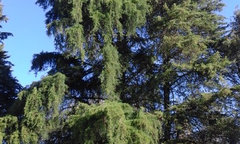
eonibm
Original Author6 years agoI think it best you start your own thread about that tree as this one is mine about the weeping alaskan cedar, not a general one to ask about different trees. Keeps things more organized that way.
Marci Forbes
3 years agoI'm very late to the party but found your post while trying to determine the difference between these two (the last photo is a mature Dense Form)
. I sent the pictures to two tree men I know and they independently identified them as CHAMAECYPARIS nootkatensis 'Pendula Dense Form' & CHAMAECYPARIS nootkatensis 'Pendula'
Also though they don't have every variety, this is a great site for pictures of a good number of conifers. https://www.iselinursery.com/colorful-conifers/
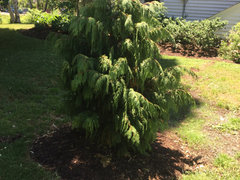
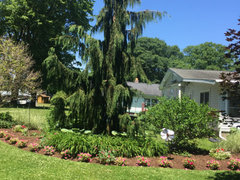
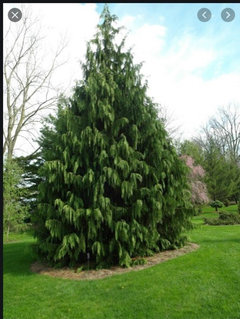
eonibm
3 years agolast modified: 3 years agoThey are wrong as I have found most who comment on it. The tree in the picture and the many I finally have (after 4 years of searching) is called 'Select Weeping Nookta Cypress', aka Weeping Alaskan Cedar, botanical name Chamaecyparis (or Cupressaceae) Nootkatensis 'Select'. Langendoen Nursery Inc, (http://www.langendoennurseries.com/) 52 Carlton St, Niagara-on-the-Lake, ON L0S 1J0, Canada grows them and supplies them wholesale to garden centres but most are gone by mid-spring.
I have had garden centres tell me that same as you have been told and then when I go see the tree or they send me a pic of their Pendula Dense Form or Pendula it is not the same. The tree is quite rare and few places offer it. That's why even garden centres and other nurseries get it wrong all the time and also why you rarely see it growing anywhere. I have seen fewer than 20 of them in all of the GTA.
When I look at the tree is reminds me of a waterfall and part of the reason I find it so beautiful, not to mention I love having a tree that rare.
gardengal48 (PNW Z8/9)
3 years ago"The tree in the picture and the many I finally have (after 4 years of searching) is called 'Select Weeping Nookta Cypress', aka Weeping Alaskan Cedar, botanical name Chamaecyparis (or Cupressaceae) Nootkatensis 'Select'."
According to the American Conifer Society, there is no cultivar of Nootka cypress registered under that name. I suspect a lot of nurseries just call them whatever they want without scrupulous attention to proper nomenclature. Also not sure how "rare" these really are.....Nootka cypress of various cultivars are dead common round here -)
eonibm
3 years agoWell I don't know where 'here' is, but I have not been able to find this cultivar at any other nursery except the one I mentioned after 4 years of searching. Every single nursery sent me pics or showed me trees that do not look anything like the one I refer to in this thread. FYI, the American Conifer Society does not happen to be the arbiter of what cultivars there are. Furthermore, 'Nootka Cypress of various cultivars' are indeed 'dead common' but the point you are missing is that the particular one I am referring to simply is not.
gardengal48 (PNW Z8/9)
3 years ago"Here" - as my screen name indicates - is the Pacific Northwest, where these trees are a native species and where many of the named forms originated. If you don't accept the ACS as a reliable source for registered cultivars of any of the various conifer species, then feel free to pick whatever gymnosperm database you like - the cultivar 'Select' does not officially exist!! That is the simplest explanation as to why your tree is so "rare" - no one else acknowledges the existence of a such a cultivar.
eonibm
3 years agolast modified: 3 years agoYet it exists...
You might want to consider that the ACS is not up-to-date.
And, sorry, as for PNW, there are a million acryonyms out there. I don't happen to know them all.gardengal48 (PNW Z8/9)
3 years agoSeed raised plants can be very different in appearance. And sorry but labeling a collection of plants with a similar appearance but of unknown provenance with a distinct (yet completely unofficial) cultivar name does not legitimize them. They can call 'em whatever they want....doesn't make it so!
eonibm
3 years agolast modified: 3 years agoI disagree. Let's leave it at that. The point is people want this cultivar and now they know where to get it. That's all that matters.
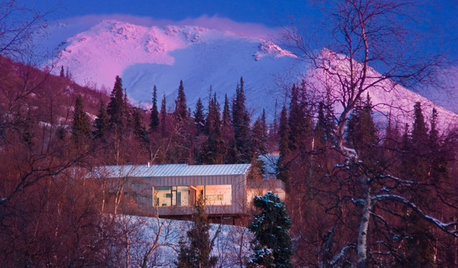


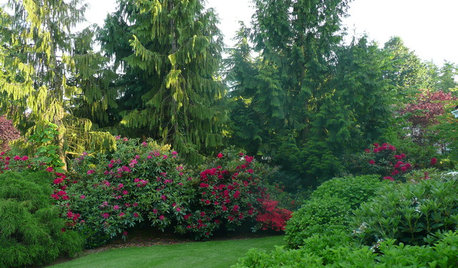

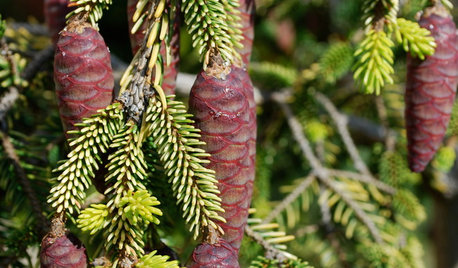
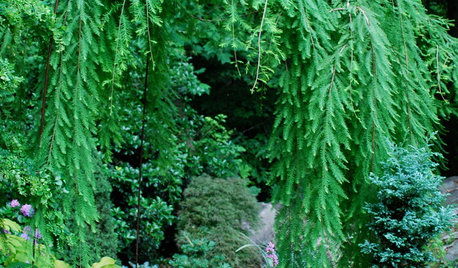
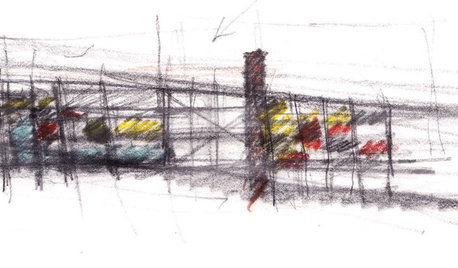

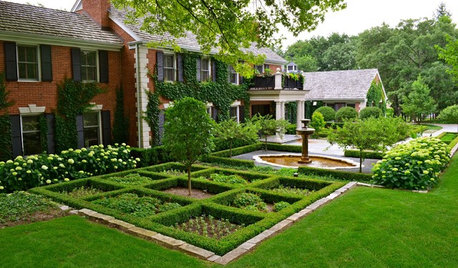






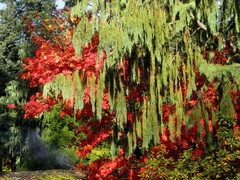
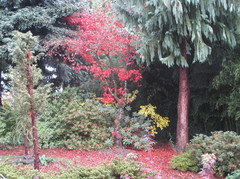
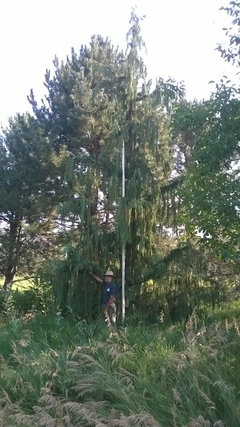
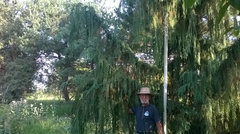
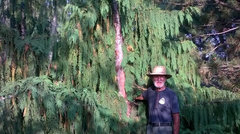




coniferjoy